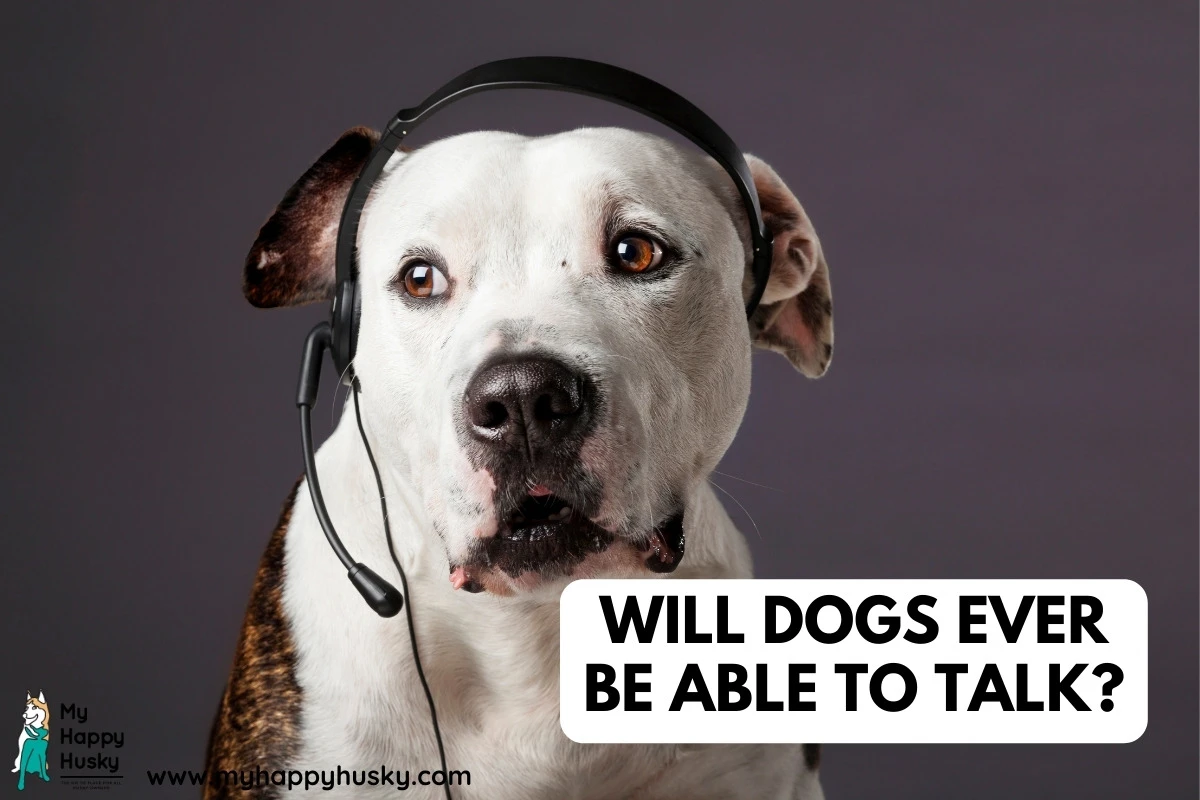Ah, the dream of every dog owner – to have a chit-chat with their furry friend. Wouldn’t that be something? Let’s delve into this fascinating topic and explore the possibilities and the science behind it.
Let’s discuss:
🐕 Will It Ever Be Possible That Dogs Learn How to Talk?
🐕 Can Dogs Understand Human Language?
🐕 What Limits Dogs From Speaking Like Humans?
🐕 Could Technology Bridge the Gap?
🐕 Hypothetical Scenario: What If Dogs Could Talk
🐕 What Does the Future Hold?

Will It Ever Be Possible That Dogs Learn How to Talk?
Dogs will likely never be able to talk like humans due to their different vocal cords and mouth structure, but advancements in technology may enhance our understanding of their communications.
Can Dogs Understand Human Language?
Dogs are pretty smart, especially when it comes to understanding us humans. They can learn to respond to verbal commands and even recognize emotional tones in our voice. Research shows that dogs can learn words, much like a human toddler. They pick up on cues, body language, and tone of voice to interpret what we’re saying. However, understanding language and being able to talk are two very different things.
What Limits Dogs From Speaking Like Humans?
Here’s where biology plays a big part. Dogs’ vocal cords and mouth structure are quite different from ours. Humans have a highly flexible larynx and a unique brain structure that supports complex speech. Dogs, on the other hand, communicate through a combination of barks, whines, and body language. While they are excellent at vocalizing their feelings and needs in their own way, replicating human speech is beyond their physical capabilities.
Could Technology Bridge the Gap?
Now, this is where it gets interesting. Technology could offer a solution. There’s ongoing research into devices that can translate dog barks and body language into human speech. Innovative tech solutions like these aim to interpret a dog’s intentions and emotions. While these devices are in their infancy and not quite like having a real conversation, they’re a step towards understanding our canine companions better.
Hypothetical Scenario: What If Dogs Could Talk
Imagine a world where your four-legged friend can actually respond back when you ask, “Who’s a good dog?” Let’s run through this delightful, albeit fictional, scenario.
Morning Greetings
You wake up not to an alarm, but to your dog saying, “Good morning! Time for a walk?” The day starts with a clear conversation about the plan. Your dog might express a preference for the park over the usual street route, or remind you that it’s time to buy more of their favorite treats.
Enhanced Communication and Bonding
As you go about your day, your dog shares their thoughts and feelings. They tell you what scares them, what makes them happy, and what they need. This deepens your bond, as you no longer have to guess what your dog is feeling or needing. They might even share insights into their behavior, like why they dislike the mailman or love chasing squirrels.
Social Dynamics
Walking your dog becomes a social event like no other. Dogs converse with each other, discussing their humans, the weather, or the latest neighborhood scents. Dog parks turn into lively forums of canine chatter. Meanwhile, you’re getting real-time translations of their conversations, understanding the social hierarchy and dynamics of the dog world.
Training and Behavior
Training sessions are revolutionized. Your dog can tell you exactly what motivates them, how they learn best, and what they’re struggling to understand. Behavioral issues are easier to address when your dog can articulate what’s bothering them or causing anxiety.
Emotional Support and Companionship
Your dog becomes an even greater source of emotional support. They offer words of comfort, understanding, and companionship. They’re not just sensing your emotions but also talking through them with you, offering a unique perspective on life’s ups and downs.
The Broader Impact
The ability of dogs to talk would have a broader impact on society. They could assist in more nuanced tasks, perhaps even participating in search and rescue missions or therapeutic settings, communicating directly about what they see and feel.
What Does the Future Hold?
So, will dogs ever be able to have a full-fledged conversation with us? Probably not in the way we imagine.
However, the future is looking bright for enhancing human-dog communication. With advances in technology and our growing understanding of animal behavior, we’re getting closer to understanding what our dogs might be ‘saying’. It’s an exciting time for dog lovers and researchers alike.
In summary, while the idea of dogs talking like humans remains in the realm of science fiction, our understanding and communication with our furry friends continue to evolve. They might not be able to discuss the weather with us, but the bond we share with dogs is a language of its own, full of love and understanding. And really, isn’t that the best kind of conversation? 🐾💬
Disclaimer
The advice given in this article is for educational purposes only and does not constitute professional advice in any context. Before making any decisions that may affect the health and/or safety of your dog, you should always consult a trained veterinarian in your local area. For the FULL disclaimer Visit HereCopyright Notice: The content produced and published on My Happy Husky is unique and original. My Happy Husky makes an active effort to search for plagiarized content using plagiarism detection software. If plagiarized content is found, action will be taken.
